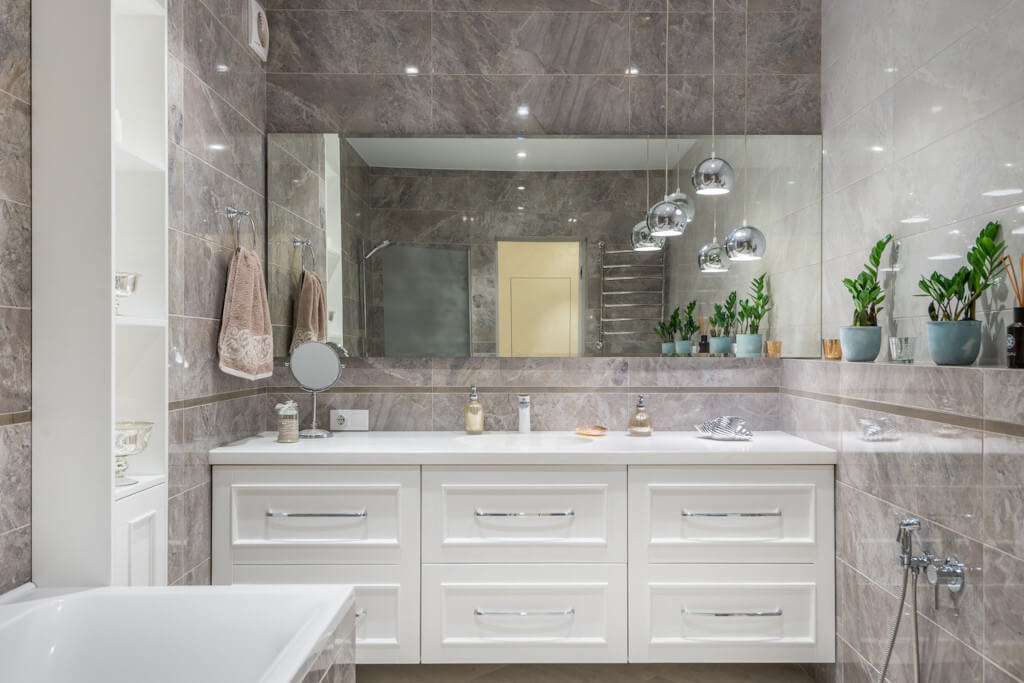When you have such a significant project taking place in your home, it is helpful to have an idea of what to anticipate. A great place to begin is by creating a bathroom remodeling checklist to meticulously plan the work that needs to be done. This can also assist you in maintaining an accurate record of your expenditures. The following is a step-by-step guide that will help you gain a better understanding of what tasks take place and when.
Create a Floor Plan for Your Bathroom
The first thing you need to do is develop a plan for the layout and functionality of your new bathroom. If you want to enjoy using it and spending quality time in it, it needs to be organized in a way that makes sense practically. There must be an orderly progression from the primary components, such as the bathtub, vanity, toilet, and shower, to the secondary ones. You can do this on paper, or you can use one of the many nifty apps or 3D modeling tools that are available to help you get the bathroom design just right. Your bathroom’s builder should be able to assist you in designing it so that it offers the greatest amount of convenience.
Demolition of the Old Bathroom
The first order of business for your builders, when they arrive on-site, will be the demolition of the old bathroom. Particularly if you are extracting the existing tiles from the floor and walls, this is a job that can be extremely noisy and messy. It will be necessary to remove them using a jackhammer, which could take several days or more depending on the size of the tiled area.
Make Plans for Your Plumbing
If you intend to make any modifications to your plumbing, this is the time when the electrician and/or plumber will reposition all of the services. They will ensure that all of the dimensions are accurate and mark the places for your new plumbing before they leave. You will need to have selected all of your fittings by this point so that they can verify that everything is going in the appropriate location and fits properly. It is important to give this some thought before moving forward with your project because relocating the plumbing can add quite a bit to the total price.
Prepare the Walls for Rendering
Once the services, such as electrical conduits and plumbing pipework, have been installed, the walls will be primed. Your walls will now have a smooth finish that is ready for tiling or painting after you do this. After removing the old tiles from a wall, you will typically be required to prepare the wall because jackhammering will typically take large chunks out of the wall.
The next step in the preparation for tiling is for your tiler to lay the cement bedding for your tiles. If they get this wrong, it will be an expensive fix. If you want your water to flow to the waste, this is an essential component.
Tiling
Your tiler is now able to tile both the floor and the walls of the bathroom. Be conscious that tilers will charge you more for mosaic tiles because installing them is more difficult and takes more time than other types of tiles.
Installation of the Finishing Touches
After the tiling has been completed, you will start to notice several modifications as your bathroom start to take shape. The plumber will now install everything in your bathroom, including your toilet, bathtub, vanity, basin, and tapware. After that, an electrician will install the lighting, ventilation fans, and any other electrical components that need to be installed.
Making a Plan for the Finances and Costs of Your Bathroom Remodel
When planning a renovation of your bathroom, you should factor in the following major costs:
- Plumbing, particularly if you are going to be relocating the plumbing or installing new components.
- tiling, which may include floor tiles as well as tiles on the walls
- a shower screen that is not framed, a shower screen that is only partially framed, or a standard shower screen
- Bath, which may be built-in or freestanding depending on preference
- A bathroom with a toilet, which may be of the standard variety or include an in-wall cistern.
- Vanity, either the traditional kind or the wall-mounted kind, makes things look tidier and frees up more floor space.
- Lighting, either the basic kind or more elaborate kinds that include downlighters and the ability to dim them
- Waterproofing, so that your bathroom won’t rot and so that you don’t have problems with dampness
Let’s Take a Closer Look at Some of These Facets and the Possible Costs Associated With Them
The Cost of the Bathroom’s Plumbing
The initial call-out fee for a plumber can range anywhere from R500 to R1000, and their hourly rates can range anywhere from R350 to R700, based on the plumber. The fee that your plumber will charge you will be determined by the location of your home and may also be affected by the plumber’s level of experience. If a plumber is providing you with a quote for a substantial project, such as the renovation of your bathroom, make sure to request an itemized quote that outlines all of the components that the plumber will be charging for. We recommend going with the plumber’s network if you want the best possible service.
The Expense of Tiling the Bathroom
Because tiling can take up a significant portion of a bathroom’s cost and because the size of your bathroom will play a significant role in the overall price of your renovation, it is important to have an estimate of how much money you might have to spend. The typical cost of laying tiles in a bathroom comes out to R200 per square meter. The cost of the tiles is not included in this; you will need to create a separate budget to cover that expense.
Wall tiles can range in price from R120 to R200 per square meter for basic white wall tiles (600mm x 300mm) to R400 per square meter for metal grey refined porcelain wall tiles. If you are interested in purchasing wall tiles, you should budget between these two prices (150mm x 600mm). As you move up the price spectrum, you can anticipate paying approximately R860 per square meter for hand-crafted Spanish white gloss ceramic subway tiles (150mm x 75mm), and R1590 per square meter for manufactured craft ceramic wall tiles (200mm x 200mm).
The Price of the Bathroom Bathtub
There is a wide range of prices for bathtubs, from more budget-friendly and flexible acrylic to more long-lasting cast iron and versatile fiberglass to luxurious natural stone. If you need a plumber to remove and replace your bathtub, you should budget at least R3500 for the job. The cost of a brand-new bathtub can range anywhere from R2000 to R200000, with stone freestanding models commanding the higher end of the price spectrum.
The Price of a Shower Screen
The price of shower screens varies depending on their size as well as whether they are framed, semi-frameless, or frameless, with the latter option being the most expensive of the three. You should budget somewhere in the area of R4000 to cover the cost of installing a standard framed shower screen. Expect to spend more than R6000 for a frameless shower screen depending on the dimensions and number of panels you want. This is because frameless shower screens use thicker glass, which drives up the price.
Cost of a Toilet
The cost of a toilet can range anywhere from R1,500 to R7,500 or even more for a floor-mounted concealed cistern or wall-hung toilet, depending on which toilet you choose. The cost of a floor-mounted toilet of good quality can range anywhere from R1500 to R4500, on average.

